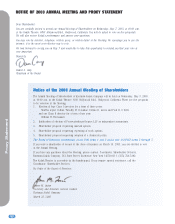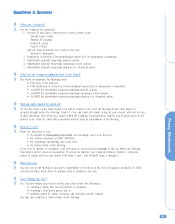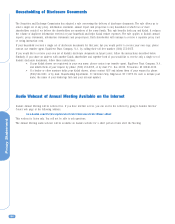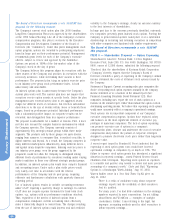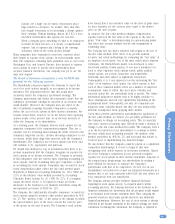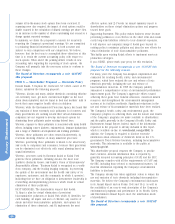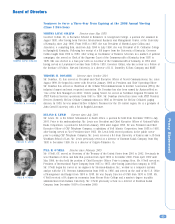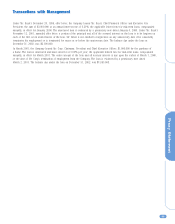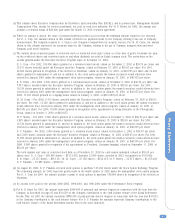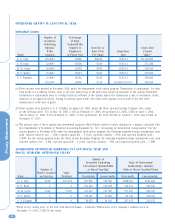Kodak 2002 Annual Report Download - page 93
Download and view the complete annual report
Please find page 93 of the 2002 Kodak annual report below. You can navigate through the pages in the report by either clicking on the pages listed below, or by using the keyword search tool below to find specific information within the annual report.
Proxy Statement
88
assume all in-the-money stock options have been exercised. If
expensing were also required, the impact of stock options could be
double counted in the calculation of diluted earnings per share; first
as an increase in the number of shares outstanding and second as a
charge against reported earnings.
In summary, we share the proponent’s concern for accurately
reporting the Company’s operational earnings. We are committed
to producing financial information that is both accurate and
subject to easy comparison with our competitors. We believe,
however, that the best way to accomplish these objectives at this
time is to retain the current accounting policy with respect to
stock options. When and if the pending debate results in new
accounting rules regarding the expensing of stock options, the
Company will promptly take the necessary action to conform to
these changes.
The Board of Directors recommends a vote AGAINST
this proposal.
ITEM 5 — Shareholder Proposal — Chemicals Policy
Donald Naulin, 8 Baymon Dr., Rochester, NY 14624, owner of 88
shares, submitted the following proposal:
“Whereas, dioxins and many similar chemicals containing chlorine
are extremely toxic, get more concentrated higher on the food
chain (bioaccumulate) and are found in food and mothers’ milk at
levels that cause negative health effects in children;
Whereas, while the Environmental Protection Agency has found that
any emission of these extremely toxic pollutants is of concern, and
many governments are working toward their virtual elimination,
companies are not required to develop and report options for
eliminating these pollutants under existing federal laws;
Whereas, exposure to these pollutants is associated with many health
effects, including cancer, diabetes, endometriosis, immune dysfunctions
and a range of children’s developmental and learning problems;
Whereas, these pollutants are often created inadvertently, by
reactions involving chlorine, in many industrial processes;
Whereas, generating these pollutants is known to be unnecessary
and costly to companies and economies, because their generation
can be eliminated cost effectively with sound planning based on
sound information;
Whereas, processes used by Eastman Kodak at Kodak Park
generate these pollutants, including dioxins, the most toxic
synthetic chemicals known; and Kodak’s Vision of Environmental
Responsibility affirms: “Eastman Kodak is recognized as a world-
class company, and the leading imaging company, in protecting
the quality of the environment and the health and safety of its
employees, customers, and the community in which it operates”;
indicating that we have an obligation to demonstrate leadership in
researching and implementing processes which result in virtual
elimination of these pollutants.
BE IT RESOLVED: The shareholders request that Kodak:
1) Adopt a plan for virtual elimination of persistent
bioaccumulative pollutants at Kodak Park which A) identifies, for
each building, all inputs and uses of chlorine, any sources of
dioxin and other bioaccumulative pollutants, and options for
elimination of these chemicals, and B) implements the most
effective option; and 2) Provide an annual summary report to
shareholders on these virtual elimination options and progress
toward these goals.
Supporting Statement: This policy makes business sense because
preventing pollution is cost effective in the short term and avoids
costly long-term liabilities related to toxic chemical exposures.
It will improve our company’s image if Kodak goes beyond its
existing policy to minimize pollution and joins the new efforts for
virtual elimination of toxic bioaccumulative pollutants.
This builds upon existing Kodak efforts to implement non-toxic
production strategies.
If you AGREE, please mark your proxy for this resolution.”
The Board of Directors recommends a vote AGAINST this
proposal for the following reasons:
For many years the Company has designed, implemented and
conducted far reaching health, safety, and environmental
programs, which have reduced the use and release of toxic
chemicals generally, including the use and release of
bioaccumulative materials. In 1998 the Company publicly
announced a comprehensive series of environmental performance
improvement goals. The Company’s aggressive efforts toward
achieving these goals have reduced emissions, conserved natural
resources and strengthened the environmental management
systems at its facilities worldwide. Significant reductions in the
use and release of bioaccumulative materials have been realized.
The Company’s health, safety and environmental goals, the
Company’s progress in achieving them, and the nature and results
of the Company’s programs are made available to shareholders
and the public generally in the Company’s Health, Safety and
Environment Annual Report. Indeed, much of the information
requested in the proposal is already included in this report,
which is available on-line at: www.Kodak.com/go/HSE. In
addition, the Company is required to disclose extensive
information about emissions of chemicals listed on the U.S.
government’s Toxics Release Inventory, including bioaccumulative
materials. This information is available to the public at
www.epa.gov/tri.
This shareholder proposal requests the Company to provide
more extensive, detailed information than is required by
generally accepted accounting principles (GAAP) and the SEC.
The Company complies with all the requirements of GAAP and
the SEC, including those related to environmental matters. All
material information regarding the Company’s environmental
liabilities is disclosed.
The Company already has taken significant action to reduce the
use and emission of toxic chemicals including bioaccumulative
materials. We believe the Company’s environmental disclosures
in its Annual Report and on Forms 10-K and 10-Q, as well as
the availability of an easy-to-read description of the Company’s
environmental programs and performance in its Health, Safety
and Environment Annual Report, meet the information needs
of shareholders.
The Board of Directors recommends a vote AGAINST
this proposal.




